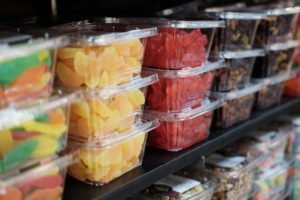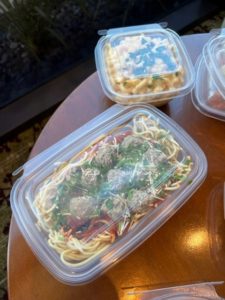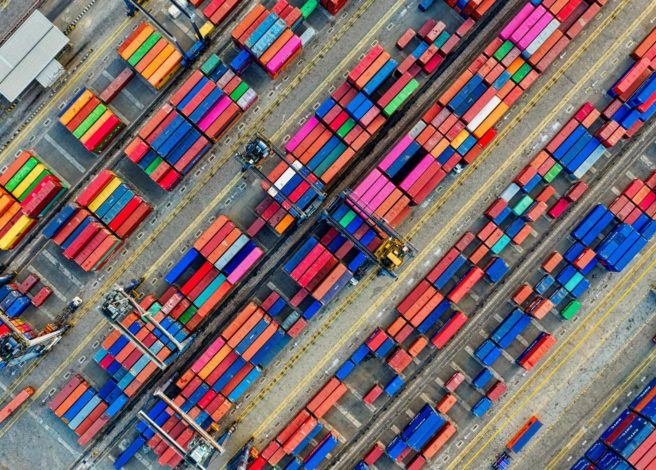At a Glance
- PET pricing stays stable due to global surplus and steady MEG supply, though PTA could face pressure from potential tariffs.
- PP is domestic and resilient, with strong U.S. production and minimal import reliance.
- Tariffs may still hit tooling, molds, and equipment, so raw materials aren’t the only concern.
- Best moves: audit your portfolio, favor domestically made PP, stay agile on sourcing, and keep an eye on trade policy.
It should come as no surprise that food industry professionals across the country are grappling with uncertainty around potential tariffs and their impact on plastic packaging costs. With trade policy discussions swirling around like delicious ingredients in a cake mixer, companies are struggling to figure out how this could impact their packaging budgets.
And let’s be honest — when every penny counts, even small cost increases can turn profit margins thin.
Here’s the challenge: International trade policy is about as clear as paper packaging (it’s a fair point). Knowing which materials might get hit, how hard, and when is tough. This uncertainty is quite distressing for food companies that need predictable packaging costs to stay competitive.
We recently chatted with a major plastic sheet supplier about how tariffs might affect raw material packaging. We walked away with valuable insights that we want to share with you today. By the end, you should clearly understand what these impacts could look like. Remember, just like cookies, you can’t make anything worthwhile without the right ingredients.
The Hidden Costs: Beyond Raw Materials
 Before we discuss the effects potential tariffs can have on the raw materials of plastic packaging, we need to make an important distinction: raw material costs represent just one piece of the packaging puzzle.
Before we discuss the effects potential tariffs can have on the raw materials of plastic packaging, we need to make an important distinction: raw material costs represent just one piece of the packaging puzzle.
Tooling and manufacturing equipment used to create custom food packaging can also be subject to tariffs. If your packaging supplier needs specialized molds for your unique container design or if processing equipment comes from overseas, these costs could be affected by separate tariff categories.
The Complete Package Picture
When evaluating packaging costs, remember you’re not just buying raw materials. You’re investing in:
- Custom tooling and molds
- Manufacturing processes
- Quality control systems
- Transportation and logistics
- Technical support and innovation
This article will focus on the potential impacts of raw material pricing.
Breaking Down Tariff Impact on Food Packaging
Let’s get right to it. We’re focusing on two materials used in food packaging:
- PET (Polyethylene Terephthalate) is excellent for clear containers that show off fresh salads.
- PP (Polypropylene) is a versatile choice for yogurt cups and microwave-safe containers.
PET in Full Transparency (No Pun Intended)
 Here’s what food professionals using PET (Polyethylene Terephthalate) packaging need to know:
Here’s what food professionals using PET (Polyethylene Terephthalate) packaging need to know:
Global surplus: The PET market is currently benefiting from strong global supply — particularly from Asia. This keeps competition high and prices relatively stable, which is great news for your bottom line.
Raw material reality: PET is made from two key ingredients: PTA (Purified Terephthalic Acid) and MEG (Monoethylene Glycol). These are like the flour and water in your packaging recipe — essential building blocks that determine cost and availability.
PTA watchlist: PTA has come under scrutiny in recent trade discussions and could be subject to potential tariffs. While there’s a temporary reprieve in place, shifts in policy or pricing could eventually ripple through to your packaging costs.
MEG stability: MEG is looking steady. The U.S. produces more than it needs and even exports the excess. That means this ingredient in your PET supply chain isn’t likely to be impacted by trade volatility anytime soon.
Bottom line: While there’s potential for fluctuation on the raw material side, the current PET landscape offers strong global availability and mostly predictable pricing — giving your procurement team some breathing room.
PP Packaging Isn’t Heating Up (Pun Intended)
 Here’s where the news gets even better for food professionals using polypropylene packaging:
Here’s where the news gets even better for food professionals using polypropylene packaging:
Domestic powerhouse: The U.S. produces about 16 billion pounds of PP annually, with a capacity of 23.8 billion pounds. Translation: We make way more than we need, creating a stable domestic supply for your packaging needs.
Import independence: Only 5% of U.S. PP consumption comes from imports, and nearly half of that comes from our neighbors in Canada. Even in worst-case scenarios, domestic production can easily cover any import shortfalls.
Raw material security: U.S. polypropylene production mainly uses domestic natural gas and propane. We have plenty of these resources, and they aren’t part of current tariff talks.
Export strength: The U.S. actually exports more PP than it imports, with Mexico as our biggest customer. While retaliatory tariffs could affect export markets, your domestic supply remains rock solid.
Your Action Plan: Staying Ahead of the Curve
Here are immediate steps you should take if you want to remain one step ahead of potential tariffs:
- Audit your current packaging portfolio. Identify which materials (PET vs. PP) account for the majority of your packaging spending.
- Plan for different outcomes: Make backup plans for various tariff results.
Your Long-term Strategy
- Diversify intelligently: Consider packaging solutions that leverage America’s PP production strength.
- Choose your partners carefully. Team up with suppliers that produce goods domestically and offer transparent pricing.
- Stay Informed: Monitor trade policy developments, but don’t let uncertainty paralyze your planning.
It’s Not All Tariff-ying
 Your competitors may worry about tariff uncertainty, but you have clear insights into how these policies impact food packaging materials. This knowledge helps you make confident decisions. It also lets you negotiate better terms with suppliers. Plus, it enables you to keep the packaging quality your customers expect.
Your competitors may worry about tariff uncertainty, but you have clear insights into how these policies impact food packaging materials. This knowledge helps you make confident decisions. It also lets you negotiate better terms with suppliers. Plus, it enables you to keep the packaging quality your customers expect.
The food industry moves fast, and packaging decisions demand perfect information. Understanding the real tariff impact on PET and PP materials helps you protect your products. It also keeps your costs in check and your business thriving.
Interested in learning more insider tips about the plastics industry? Visit our Learning Center today!

